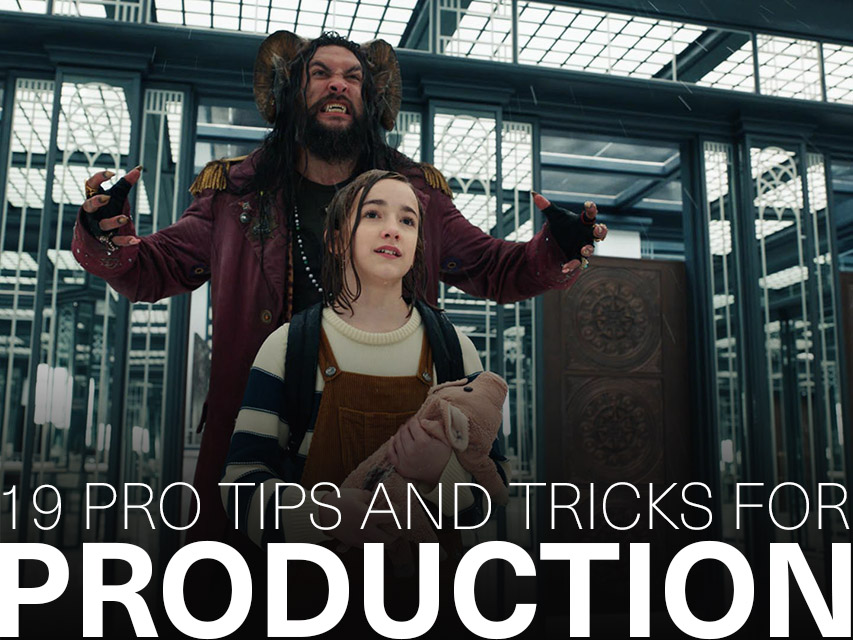Be the first to know — Get Outpost's monthly newsletter for news, tips and job opportunities.

News
19 Pro Tips and Tricks for Production
17 February 2023
Our talented Production team takes you through 19 of their best time-saving, organisational tips that have helped them in their careers
To be successful in a Production team there are a few things you’ll need to master: time keeping, clear and concise communication and impeccable organisational skills. Luckily, our brilliant Production teams across all five sites are willing to share their top tips and tricks that will help you to excel in Production; from time-saving apps to important soft skills.
A big thanks to Production Coordinators Riley Gerenda, John Moseley-Williams and Megan Hartey, VFX Coordinator Blake Bowen, Production Manager Ilse Martinez for sharing their Production wisdom.
01. Communication is key
If you’re looking to join production, having great communication skills is one of the most important skills you can have. You can learn all the jargon and be trained in your role but knowing how to talk to people and build relationships is imperative to being successful in this department. Clear, concise communication and a positive, upbeat attitude about the day goes a long way in maintaining a positive outlook for a team on a project.
02. Don’t try to learn it all at once
Try not to be too overwhelmed by learning the ropes immediately – we know, easier said than done. The people you work with will be supportive of a learning curve, and oftentimes your success will only aid in their own, the project’s, and the company’s. It’s a win-win that your team help you through the growing pains, and eventually you will get it. So don’t be afraid to ask questions about VFX as a whole or something more specific in processes and the way something is done. Using the resources in front of you will only help grow relationships and your knowledge on the role you play.
03. Build strong relationships with the team around you
Growing and nurturing relationships in the studio and company is really important in production. It’s great to get to know the people you’re working for and with, and it helps having that camaraderie to break up weeks full of dailies, deliveries, and ever-impending due dates. Having such easy back and forth definitely feeds into the collaborative experience of a successful project! It’s so fun to know those around you everyday, and it makes it a little easier to nudge co-workers with any questions or needs when you know them well and understand how to communicate with them on individual levels.
04. Be ultra-organised
It may seem simple but being organised and on top of what’s needed for a project is massive in keeping a schedule moving forward. Whether it’s jotting down materials requests that a supe or artist needs from a client, or maintaining online tracking, production is responsible for making sure information is up-to-date to uphold expectations to and from artists. At the end of the day, we’re the ones communicating with everyone – the client, the artists, and the supervisors – and it’s vital we’re on top of where we’re at and what we need!
05. Learn your keyboard shortcuts
As part of a busy production team, finding ways to streamline your work will help you in the long run. Knowing your keyboard shortcuts is a great way to do this; here are some of our favourites:
Ctrl+Shift+T - Open last closed tab (Chrome)
Ctrl+Tab or Ctrl+Shift+Tab - Next/Previous Tab (Chrome)
Ctrl+Mouse Click - Open link in new tab (great for saving RPM annotations from ShotGrid!)
Windows+V - Clipboard (Copy/Paste history)
Windows+Arrow Key - Window Snapping
06. Download Bulk Rename Utility
This software is especially helpful for renaming RPM annotations or copying shot lists from file trees. Side note: you can easily rename a single file in File Explorer by pressing F2 instead of Right Click>Rename – every click you can reduce is time saved.
07. Download Greenshot
One of the best screenshot software available which is free for Windows users. Extra tip: download the unstable release v1.3.xxx (https://getgreenshot.org/version-history/). Some of the production team have been using it for over two years and have found nothing ‘unstable’ about it but this release adds a lot of really useful features that are not in the official release.
08. Get (well) acquainted with Excel/Sheets
Formulas, shortcuts, filters, conditional formatting, data validation, etc. These will be your best friend and make production life much easier.
09. Keep a positive attitude
Production can be stressful, both for you and those around you. Last minute client notes, pushes to deadlines, and tech issues can all take a toll and make a project seem endless and dull. As a production member it’s so important to keep a positive attitude to help keep the team going, don’t be afraid to laugh or admit when times are tough – it'll go a long way in keeping you sane.
10. Don’t be afraid to ask for help – or give it
Like any job, we are all constantly learning and the best way to keep learning is to trust in those around you. Don't be afraid to ask for help or even offer it if you see someone struggling. Even when on different shows we’re all on the same team and it’s important to keep helping one another.
11. Keep a cool head
Try to keep calm under pressure. Last minute sends, multiple artists asking you questions at the same time, or frantic dailies sessions can quickly become overwhelming. Prioritise your tasks, remember to breathe and remind yourself you’re not alone – you have a team around you for support.
12. It’s never too early to start learning
If you're not yet in production and looking for an entry level role, a good idea would be to start learning the VFX pipeline even before you land the opportunity. Every VFX studio varies a little bit, but having a good basic knowledge is going to make your first few weeks a little easier. There are a lot of VFX pipeline learning resources online, but here's a starting point if you need it.
13. Learn about the software
There are various production tracking tools, and every studio adapts their tool to their own needs, but the industry standard is ShotGrid. Autodesk has a great YouTube channel for ShotGrid training, so even if you haven't had a chance to get your hands on a license through a studio, I highly recommend that you check out their videos. It will give you a starting point so when you kick off your VFX career, you'll feel familiar in the surroundings. Get started with ShotGrid's YouTube here.
14. Be open to learning from those around you
As you start gaining experience with years in the industry, it's important to remember that no matter how comfortable you feel with your VFX knowledge, your artists, leads, and supervisors are the experts of their craft. Keep an open mind and be flexible. The best way to gain and keep the trust of your creative team is by trusting them back.
15. Take a minute to save a Supe 30 seconds
Supervisors have really busy jobs, and everything goes through them which can create a bottleneck at times. Using ShotGrid fields like "Production Notes" and "Sort Order" to prioritise versions in a playlist really helps to optimise their time. You can also use the "Task by Planner" app in Microsoft teams to create to-do lists for the Supes which you can also attach priorities to.
16. Ask your artist team questions when communicating targets
The show schedule is Production’s best guess at an ideal workflow. The artists are going to be the first to find the wrinkles in that ideal. So be transparent about what your expectations are and be receptive to the reasons they might give on why a target is unrealistic. If you catch a problem early enough, you may avoid a big push in the schedule.
17. Get specific with Editorial
Your Editorial team is your best friend in Production. Similar to your Supervisors – if you can spend a bit of extra time making their lives easier, it’s well worth it. We use a ticket system for editorial requests. If you use a similar system, prioritise your tickets for your Editors and be specific with your requests.
18. Save your own ShotGrid Pages
Default ShotGrid pages can be really useful at times, but they can be a bit too broad and have too much information. Your day to day is probably a lot more specific and so you can use the Design Page to create custom views and filters that narrow in on the department/artists you work with all the time. You can ask your Production Managers or fellow team members about pages they use as well.
19. Have fun and be personable!
Try to make your meetings and chats a welcoming place for the people you work with. It goes a long way.







